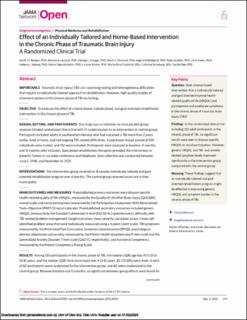| dc.description.abstract | Importance Traumatic brain injury (TBI) can cause long-lasting and heterogeneous difficulties that require an individually tailored approach to rehabilitation. However, high-quality studies of treatment options in the chronic phase of TBI are lacking.
Objective To evaluate the effect of a home-based, individualized, and goal-oriented rehabilitation intervention in the chronic phase of TBI.
Design, Setting, and Participants This study was an intention-to-treat parallel-group assessor-blinded randomized clinical trial with 1:1 randomization to an intervention or control group. Participants included adults in southeastern Norway who had sustained a TBI more than 2 years earlier, lived at home, and had ongoing TBI-related difficulties. A population-based sample of 555 individuals were invited, and 120 were included. Participants were assessed at baseline, 4 months, and 12 months after inclusion. Specialized rehabilitation therapists provided the intervention in patients’ homes or via video conference and telephone. Data collection was conducted between June 5, 2018, and December 14, 2021.
Interventions The intervention group received an 8-session individually tailored and goal-oriented rehabilitation program over 4 months. The control group received usual care in their municipality.
Main Outcomes and Measures Preestablished primary outcomes were disease-specific health-related quality of life (HRQOL; measured by the Quality of Life After Brain Injury [QOLIBRI] overall scale) and social participation (measured by the Participation Assessment With Recombined Tools–Objective [PART-O] social subscale). Preestablished secondary outcomes included generic HRQOL (measured by the EuroQol 5-dimension 5-level [EQ-5D-5L] questionnaire), difficulty with TBI-related problem management (target outcomes; mean severity calculated across 3 main self-identified problem areas that were individually measured using a 4-point Likert scale), TBI symptoms (measured by the Rivermead Post Concussion Symptoms Questionnaire [RPQ]), psychological distress (depression and anxiety; measured by the Patient Health Questionnaire 9-item scale and the Generalized Anxiety Disorder 7-item scale [GAD-7], respectively), and functional competency (measured by the Patient Competency Rating Scale).
Results Among 120 participants in the chronic phase of TBI, the median (IQR) age was 47.5 (31.0-55.8) years, and the median (IQR) time since injury was 4 (3-6) years; 85 (70.8%) were male. A total of 60 participants were randomized to the intervention group, and 60 were randomized to the control group. Between baseline and 12 months, no significant between-group effects were found for the primary outcomes of disease-specific HRQOL (QOLIBRI overall scale score: 2.82; 97.5% CI, −3.23 to 8.88; P = .30) or social participation (PART-O social subscale score: 0.12; 97.5% CI, −0.14 to 0.38; P = .29). At 12 months, the intervention group (n = 57) had significantly higher generic HRQOL (EQ-5D-5L score: 0.05; 95% CI, 0.002-0.10; P = .04) and fewer symptoms of TBI (RPQ total score: −3.54; 95% CI, −6.94 to −0.14; P = .04) and anxiety (GAD-7 score: −1.39; 95% CI, −2.60 to −0.19; P = .02) compared with the control group (n = 55). At 4 months only, the intervention group (n = 59) had significantly less difficulty managing TBI-related problems (target outcomes mean severity score: −0.46, 95% CI, −0.76 to −0.15; P = .003) compared with the control group (n = 59). No adverse events were reported.
Conclusions and Relevance In this study, no significant results were observed for the primary outcomes of disease-specific HRQOL or social participation. However, the intervention group reported improvements in secondary outcomes (generic HRQOL and symptoms of TBI and anxiety) that were maintained at 12-month follow-up. These findings suggest that rehabilitation interventions could help patients even in the chronic phase of TBI.
Trial Registration ClinicalTrials.gov Identifier: NCT03545594 | en_US |

